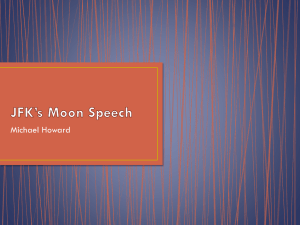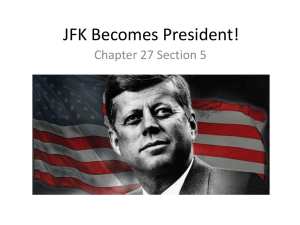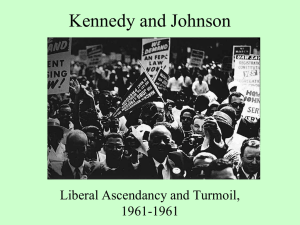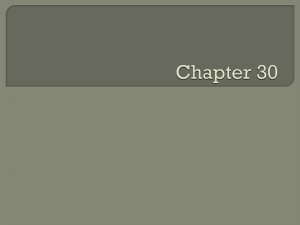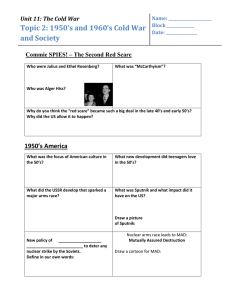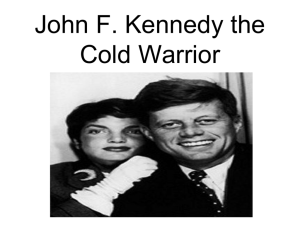THE NEW FRONTIER KENNEDY AND JOHNSON LEAD AMERICA IN THE
advertisement
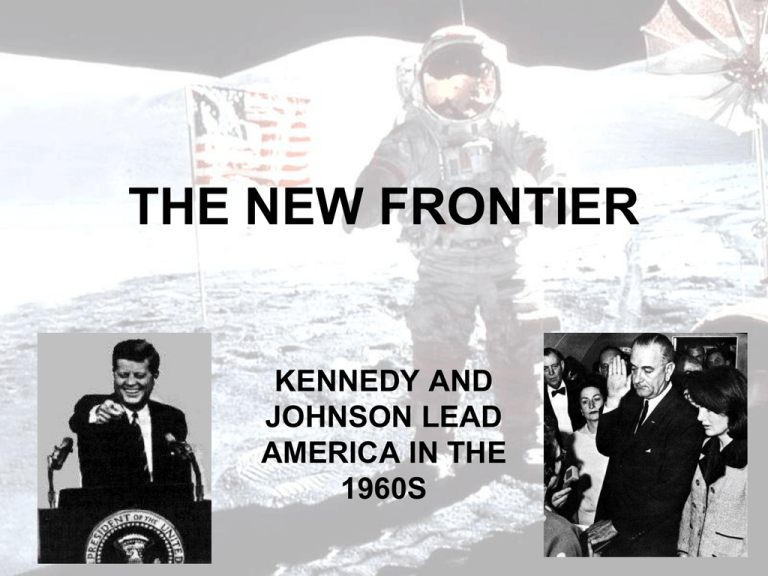
THE NEW FRONTIER KENNEDY AND JOHNSON LEAD AMERICA IN THE 1960S SECTION 1: KENNEDY AND THE COLD WAR Senator Kennedy, • • • • JFK Chap. 1 Democratic nominee for president in 1960 was a young Massachusetts senator named John Kennedy-handsome and charismatic Promised “get America moving again” The Republicans nominated Richard Nixon, Ike’s VicePresident Two factors helped put Kennedy over the top: TV and Civil Rights 1958 TELEVISED DEBATE AFFECTS VOTE Kennedy Looked Better • On September 26, 1960, Kennedy and Nixon took part in the first televised debate between presidential candidates • Kennedy looked and spoke better than Nixon – JFK looked cool, collected, presidential U.SII 8 c, d; 9c JFK’S OTHER EDGE: CIVIL RIGHTS Sit-Ins were non-violent protests over the policy of whites-only lunch counters in the South • A second major event of the campaign took place in October, 1960 • Police arrested Martin Luther King for conducting a “Sit-In” at a lunch counter in Georgia • King was sentenced to hard labor JFK, NIXON REACT DIFFERENTLY TO KING ARREST • While the Eisenhower Administration refused to intervene, JFK phoned King’s wife and his brother, Robert Kennedy, worked for King’s release • The incident captured the attention of the African-American community, whose votes JFK would carry in key states King Kennedy KENNEDY WINS CLOSE ELECTION U.SII 8 c, d; 9c “ASK NOT . . .JFK Chap. 3 Delivered Friday, January 20, 1961 In his inaugural address, JFK uttered this famous challenge: “Ask not what your country can do for you --- ask what you can do for your country” FOCUS ON THE COLD WAR • From the beginning of his term in early 1961, JFK focused on the Cold War (Soviet relations) • JFK tripled our nuclear capability, increased troops, ships and artillery, and created the Green Berets (Special Forces) CRISIS OVER BERLIN SAFARI Montage chap 3 The Cold War • In 1961, Berlin, Germany was a city in great turmoil • In the 11 years since the Berlin Airlift, almost 3 million East Germans (Soviet side) had fled into West Berlin (U.S. controlled) to flee communist rule SOVIETS SEEK TO STOP EXODUS: ABC: Cold War Escalates Chap. 3 East Germany begins construction on the Berlin Wall, which becomes a primary symbol of the Cold War and Soviet oppression • The Soviets did not like the fact that East Berliners were fleeing their city for the democratic west • Their departure hurt the economy and the prestige of the USSR • Just after midnight on August 13, 1961 the Soviets began construction of a 90-mile wall separating East and West Berlin Modern Marvels video Berlin Wall if Time CRISIS OVER CUBA SAFARI Montage chap. 3 Freedom Hist of US • Just 90 miles off the coast of Florida, Cuba presented the first big test of JFK’s foreign policy • Openly Communist, Cuba was led by revolutionary leader Fidel Castro who welcomed aid from the USSR • Relations between the U.S. and Cuba were deteriorating U.SII 8 c, d; 9c BAY OF PIGS “We looked like fools to our friends, rascals to our enemies and incompetents to the rest” Quote from U.S. Commentator • In March 1960, Eisenhower gave the CIA permission to secretly train Cuban exiles for an invasion of Cuba • Kennedy learned of the plan only nine days into his presidency • JFK approved the mission • It turned out to be a disaster when in April, 1961, 1,200 Cuban exiles met 25,000 Cuban troops backed by Soviet tanks and were soundly defeated THE CUBAN MISSILE CRISIS np page 15 and show photos JFK Chap. 4 10 min. • Castro had a powerful ally in Moscow • Soviet leader Nikita Khrushchev promised to defend Cuba with Soviet weapons • During the summer of 1962 the flow of Soviet weapons into Cuba – including nuclear – increased greatly KENNEDY RESPONDS American president John F Kennedy making his dramatic television broadcast to announce the Cuba blockade during the Cuban Missile Crisis • Kennedy made it clear the U.S. would not tolerate nuclear weapons in Cuba • When surveillance photos revealed nukes ready to launch in Cuba, JFK said the U.S. would respond to any attack from Cuba with an allout nuclear retaliation against the Soviets 13 DAYS • When more Soviet ships headed for the U.S. with weapons, JFK ordered a blockade • The first break in the crisis occurred when the Soviets ships turned back • Finally, Khrushchev agreed to remove the nuclear weapons from Cuba in exchange for a U.S. promise NOT to invade Cuba For 13 days in October, 1962 the world stood still as the threat of nuclear war gripped the planet EASING TENSIONS • Both Khrushchev and Kennedy began searching for ways to ease the enormous tension between the two superpowers • In 1963 they established a hot line between the White House and the Kremlin • Later that year, the superpowers signed a Limited Test Ban Treaty that served to ban nuclear testing in the atmosphere SECTION 2: THE NEW FRONTIER • Kennedy began his vision in a program he called “The New Frontier” • The economy, education, medical care for the elderly and the poor, and space exploration were all part of his vision THE COLD WAR TAKES TO THE SKIES • The Space Race was initially dominated by the Soviets • On October 4, 1957, they launched Sputnik, the world’s first artificial satellite • Sputnik traveled around earth at 18,000 miles an hour, circling the globe every 96 minutes RACE TO THE MOON SAFARI Montage chap 4 ABC Part II zvd: Boy Meets World Review You Tube Part One Boy Part Two Boy Part Three Boy and show memo from space • Started with Sputnik. • On April 12, 1961, Soviet cosmonaut Yuri Gagarin became the first human in space • Meanwhile, America’s space agency (NASA) began construction on new launch facilities in Cape Canaveral, Florida and a mission control center in Houston, Texas A MAN ON THE MOON • Finally, on July 20, 1969, the U.S. would achieve its goal • An excited nation watched as U.S. astronaut Neil Armstrong took the first steps on the moon • Space and defense-related industries sprang up in Southern and Western states Armstrong “One small step for man, one giant leap for mankind” KENNEDY ADDRESSES RACISM • In 1963, Kennedy called for “a national assault on the causes of poverty” • He also ordered his brother, Attorney General Robert Kennedy to investigate racial injustice in the South • Finally, he presented Congress with a sweeping civil rights bill and a sweeping tax cut bill to spur the economy U.SII 8 c, d; 9c TRAGEDY IN DALLAS You Tube Google • On a sunny day on November 22,1963, JFK received warm applause from the crowd that lined the downtown streets of Dallas as he rode in the back seat of an open-air limousine… JFK SHOT TO • DEATH As the motorcade approached the Texas Book Depository, shots rang out • JFK was shot in the neck and then the head • His car was rushed to a nearby hospital where doctors frantically tried to revive him • President Kennedy was dead (11/22/63) JFK LAID TO REST Three-year old John Kennedy Jr. salutes his father’s coffin during the funeral • All work stopped for Kennedy’s funeral as America mourned its fallen leader • The assassination and the televised funeral became historic events • Like 9-11, Americans can recall where they were when they heard the news of the President’s death LEE HARVEY OSWALD CHARGED; SHOT TO DEATH • A 24-year-old Marine with a suspicious past left a palm print on the rifle used to kill JFK • He was charged and a national audience watched his transfer from one jail to another, nightclub owner Jack Ruby broke through the crowd and shot Oswald to death Jack Ruby, right, shoots Oswald, center, to death 11/24/63 UNANSWERED QUESTIONS JFK Assassination Magic Bullet Computer Recreation - YouTube • The bizarre chain of events led many to believe that Oswald was part of a conspiracy • The Warren Commission investigated the assassination and determined that Oswald had indeed acted alone • Recent filmmaker Oliver Stone isn’t so sure – his film, “JFK,” is filled with conspiracy theories LYNDON BAINES JOHNSON BECOMES PRESIDENT • The Vice-President, Lyndon Baines Johnson, became President after JFK was assassinated • The nation mourned the death of the young president. A somber LBJ takes the oath of office aboard Air Force One with the Jackie next to him • Complete Page 14 Recap of Power point #2 If Time Complete the Rest of the Slides THE WAR ON POVERTY • Following his tax cut and Civil Rights Act successes, LBJ launched his War on Poverty • In August of 1964 he pushed through Congress a series of measures known as the Economic Opportunity Act • The Act provided $1 billion in aid to the inner city U.SII 8 c, d; 9c ECONOMIC OPPORTUNITY ACT THE EOA legislation created: • The Job Corps • VISTA (Volunteers in service to America) • Project Head Start for underprivileged preschoolers • The Community Action Program which encouraged the poor to participate in public works program Project Head Start is still going U.SII 8 c, d; 9c strong BUILDING THE GREAT SOCIETY • In May of 1964, LBJ summed up his vision for America in a phrase: “The Great Society” • By the time he left the White House in 1969, Congress had passed 206 of LBJ’s Great Society legislative initiatives U.SII 8 c, d; 9c EDUCATION • Johnson considered education “the key which can unlock the door to the Great Society” • The Elementary and Secondary Education Act provided $1 billion to help public schools buy textbooks and library materials • This Act represented the first major federal aid package for education ever U.SII 8 c, d; 9c HEALTHCARE • LBJ and Congress enhanced Social Security by establishing Medicare and Medicaid • Medicare provided hospital insurance and low-cost medical care to the elderly • Medicaid provided health benefits to the U.SII 8 c, d; 9c poor HOUSING Weaver • LBJ and Congress appropriated money to build 240,000 units of low-rent public housing; established the Department of Housing and Urban Development (HUD) and appointed the first black cabinet member, Robert Weaver, as HUD’s first leader U.SII 8 c, d; 9c IMMIGRATION REFORM • The Great Society also brought reform to immigration laws • The Natural Origins Acts of the 1920s strongly discriminated against immigration by those outside of Western Europe • The Immigration Act of 1965 opened the door for many non-European immigrants to settle in the U.SII 8 c, d; 9c U.S. THE ENVIRONMENT • LBJ also actively sought to improve the environment • The Water Quality Act of 1965 required states to clean up their rivers and lakes • LBJ also ordered the government to clean up corporate polluters of the environment U.SII 8 c, d; 9c CONSUMER PROTECTION • Consumer advocates also made gains during the 1960s • Major safety laws were passed in the U.S. auto industry and Congress passed the Wholesome Meat Act of 1967 • LBJ said, “Americans can feel safer now in their homes, on the road, and at the U.SII 8 c, d; 9csupermarket” SUPREME COURT REFORMS SOCIETY, TOO Warren • Reform and change were not limited to the Executive and Legislative branches • The Judicial Branch led by the Supreme Court and Chief Justice Earl Warren did much to U.SII 8 c, d; 9c protect individual rights WARREN COURT AND SUSPECT’S RIGHTS • In Mapp v. Ohio (1961) the Supreme Court ruled that illegally seized evidence could not be used in court • In Escobedo v. Illinois the court ruled that the accused has the right to have an attorney present when questioned by police • In Miranda v. Arizona the court ruled that all suspects must be read their rights U.SII 8 c, d; 9c before questioning IMPACT OF GREAT SOCIETY • The Great Society and the Warren Court changed the United States • No president in Post-WWII era extended the power and reach of the federal government more than LBJ • The War on Poverty helped, the Civil Rights initiative made a difference and the massive tax cuts spurred the economy U.SII 8 c, d; 9c U.SII 8 c, d; 9c
